|
Small Bird, Powerful Voice: Wrens are mainly small and inconspicuous except for their loud songs. These birds have short wings and a thin down-turned bill. Several species often hold their tails upright. All are insectivorous.
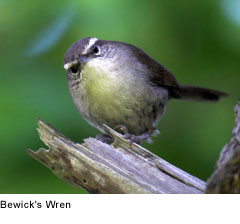 Wrens Around the Globe: Only one species, Troglodytes troglodytes, known as the Winter Wren in North America, occurs in the Old World, where it is commonly known simply Wrens Around the Globe: Only one species, Troglodytes troglodytes, known as the Winter Wren in North America, occurs in the Old World, where it is commonly known simply
as the Wren.
The 27 Australasian
"wren" species are unrelated and
are in the family Maluridae, as
are the New Zealand wrens in the
family Acanthisittidae.
Crevise Comforts: At night, usually in winter, it often roosts, true to its name, in dark retreats, snug holes and even old nests. In hard weather it may do so in parties, either consisting of the family or of many individuate gathered together for warmth.
You Can Never Have Too Many... The male Wren builds several nests, up to 6 or 7 in Europe, but fewer in North America. These are called "cock nests" but are never lined until the female chooses one to use.
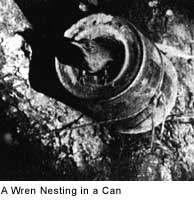 Nest and Nestlings: The normal round nest of grass, moss, lichens or leaves is tucked into Nest and Nestlings: The normal round nest of grass, moss, lichens or leaves is tucked into
a hole in a wall, tree trunk, crack in a rock or corner of a building, but it is often built in bushes, overhanging boughs or the litter which accumulates in branches washed by floods.
Five to eight white or slightly speckled eggs are laid in April, and second broods are reared.
The eggs of the St. Kilda Wren are marginally larger and often more boldly spotted; six is the usual number.
----------------------------------------------------------------------------------------------------------------------------
Cactus Wren: The Cactus Wren (Campylorhynchus brunneicapillus) is the largest North American wren, and is 18-23 cm (7-9 inches) long.
Seen and Heard: Unlike the smaller wrens, the Cactus Wren is easily seen. It has the loud voice characteristic of wrens, but its song is harsh and unmusical, and it is much less shy than most of the family. Its marked white eye stripe, brown head, barred wings and tail, and spotted tail feathers make it easy to identify. Like most birds in its genus, it has slightly curved bill. There is little sexual dimorphism.
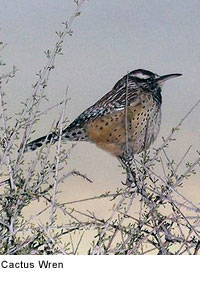 Desert Dweller: The Cactus Wren is native to the south-western United States southwards to central Mexico. It is a bird of arid regions, and is often found around yucca, mesquite or saguaro; it nests in cactus plants, sometimes in a hole in a saguaro, sometimes where its nest will be protected by the prickly cactus spines of a cholla or leaves of a yucca. It mainly eats insects, though it will occasionally take seeds or fruits. It rarely drinks water, getting its moisture from its food. Desert Dweller: The Cactus Wren is native to the south-western United States southwards to central Mexico. It is a bird of arid regions, and is often found around yucca, mesquite or saguaro; it nests in cactus plants, sometimes in a hole in a saguaro, sometimes where its nest will be protected by the prickly cactus spines of a cholla or leaves of a yucca. It mainly eats insects, though it will occasionally take seeds or fruits. It rarely drinks water, getting its moisture from its food.
"Its Us Against the World!" The Cactus Wren forms permanent pair bonds, and the pairs defend a territory where they live all through the year.
---------------------------------------------------------------------------------------------------------------------------
Winter Wren: The Winter Wren (Troglodytes troglodytes) is a very small bird, a member of the mainly New World wren family Troglodytidae. It is the only wren which occurs in the Old World. In Europe it is commonly known simply as the Wren. The scientific name, meaning "cave-dweller", refers to its habit of disappearing into cavities or crevices whilst hunting arthropods or to roost.
Just the Facts: It is common in Europe, a belt of Asia from northern Iran and Afghanistan across to Japan, and North America. It is only migratory in the northern parts of its range. The 9-10.5 cm long Wren is rufus brown above, grayer beneath, barred with darker brown and gray, even on wings and tail. The bill is dark brown, the legs pale brown. Young birds are less distinctly barred.
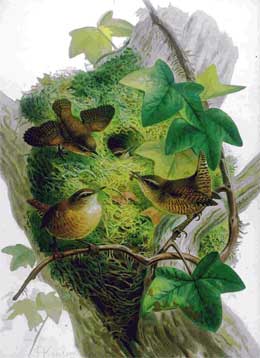 Feathers A'Field: The plumage is subject to considerable variation, and where populations have been isolated, the variation has become fixed in one minor form or another. There are around 27 Eurasian subspecies of this taxonomically complex bird, with around 12 more in North America. The disputed subspecies orii, the Daito Winter Wren, became extinct around 1940. Feathers A'Field: The plumage is subject to considerable variation, and where populations have been isolated, the variation has become fixed in one minor form or another. There are around 27 Eurasian subspecies of this taxonomically complex bird, with around 12 more in North America. The disputed subspecies orii, the Daito Winter Wren, became extinct around 1940.
Thus in the British Isles, in addition to the typical bird, T. t. indigenus, there are two distinct insular forms; one, T. t. hirtensis, is confined to the island of St Kilda, and another, T. t zetlandicus to Shetland. The St. Kilda Wren is grayer above, whiter beneath, and with more abundant bars on the back; the Shetland Wren is darker.

Classification Confusion: Recent DNA and vocalization studies suggest that the subspecies in Alaska and the Aleutian Islands, which has a harsher, more complex song, may well be a different species from the eastern North American and European forms. The latter two populations are also genetically distinct, but possibly not sufficiently to be split as separate species. This research did not include the distinctive Scottish forms.
All Around Wren: The small, stump-tailed Wren is almost as familiar in Europe as the Robin. It is mouse-like, easily lost sight of when it is hunting for food, but is found everywhere from the tops of the highest moors to the
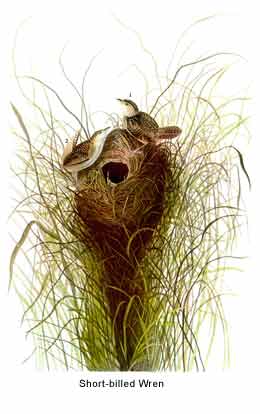 sea coast. sea coast.
Stump-tailed and Fascinating:
Its movements as it creeps or climbs are incessant rather than rapid; its short flights swift and direct but not sustained, its tiny round wings whirring as it flies from bush to bush. When annoyed
or excited its call runs into an emphatic chirr, not unlike clockwork running
down. Its song is a gushing burst of sweet music, loud and emphatic. It
has an enormous voice for its size, ten times louder, weight for weight, than
a cockerel.
Individuals vary in volume as well as quality of song. The song begins
with a few preliminary notes, then runs into a trill, slightly ascending, and ends
in full clear notes or another trill.
At all and any season the song may
be heard, though most noticeable
during spring.
All text is available under the terms
of the GNU Free Documentation License
|